NavSource Online: Submarine Photo Archive
Robalo (SS-273)
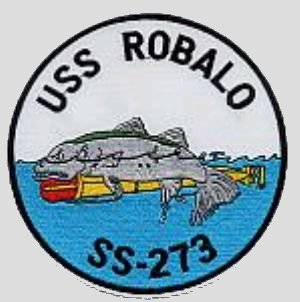
Contributed by John Hummel

![]()
![]()
![]()
![]()
Gato Class Submarine: Laid down, 24 October 1942, at Manitowoc Shipbuilding Co, Manitowoc, WI.; Launched, 9 May 1943; Commissioned USS Robalo (SS-273), 28 September 1943; Sunk on 3rd patrol by a mine, 26 July 1944, off the east coast of Balabac Island, PI, 4 men rescued, died as Japanese POWs; Struck from the Naval Register, 16 September 1944. Robalo received 2 battle stars for World War II service.
Found by the Sea Scan Survey Team in May, 2019, near Palawan Island in the Philippines. Her identity has been confirmed by the U. S. Navy.
Photos from the dive team of projectgato can be viewed here. Specifications: Displacement, Surfaced: 1,526 t., Submerged: 2,424 t.; Length 311' 9"; Beam 27' 3"; Draft 15' 3"; Speed, Surfaced 20.25 kts, Submerged 8.75 kts; Complement 6 Officers 54 Enlisted; Operating Depth, 300 ft; Submerged Endurance, 48 hrs at 2 kts; Patrol Endurance 75 days; Cruising Range, 11,000 miles surfaced at 10 kts; Armament, ten 21" torpedo tubes, six forward, four aft, 24 torpedoes, one 3"/50 deck gun, two .50 cal. machine guns, two .30 cal. machine guns; Propulsion, diesel electric reduction gear with four General Motors main generator engines, 5,400HP, Fuel Capacity, 116,000 gal., four General Electric main motors, 2,740HP, two 126-cell main storage batteries, twin propellers.
| Click On Image For Full Size | Size | Image Description | Source | |
|---|---|---|---|---|
 | 95k | Centropomus undecimalis, a common snook. The common snook is also known as the sergeant fish or ro'balo. | Photo & text courtesy of wapedia.mobi. | |
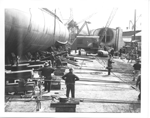 0827327 | 919k | Close up view of the port side hull of the Manitowoc built submarine Robalo (SS-273) on the ways at Manitowoc Shipbuilding Company with workers preparing for launch on 9 May 1943. What could be the hull of the Rock (SS-274) appears behind the Robalo. | Photo by Harry Berns, Official photographer of the Manitowoc Shipbuilding Co., Manitowoc, WI., Submitted by Hanah Patten, Registrar,Wisconsin Maritime Museum, Manitowoc, WI. This photo, # P70-7-205, can be ordered from the Wisconsin Maritime Museum | |
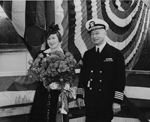 | 270k | Submarine Robalo (SS-273), hull #321 on launching day, 9 May 1943. Mrs E. S. Root sponsor, and unidentified captain (possibly Stephen Ambruster) on christening platform. Note the X in the circle in the middle of the hole in the bunting, marking the correct spot to strike with the launching bottle. | Photo by Harry Berns, Official photographer of the Manitowoc Shipbuilding Co., Manitowoc, WI. Submitted by Susan Menk, Archives Assistant, Manitowoc Shipbuilding Co., Manitowoc, WI. This photo, # 2001-1-387, can be ordered (without the watermark) from the Wisconsin Maritime Museum. | |
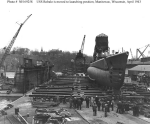 | 102k | The Robalo (SS-273) is moved over to the waterfront launching position at Manitowoc Shipyards, Manitowoc, Wisconsin, April 1943. Note the small floating drydock at left. | Photo by Harry Berns, Official photographer of the Manitowoc Shipbuilding Co., Manitowoc, WI. USNHC photograph USNHC # 69258, courtesy of the Manitowoc Submarine Memorial Association, Manitowoc, Wisconsin, 1969. |
|
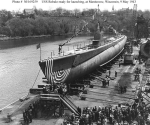 | 161k | Robalo (SS-273) ready for launching, at Manitowoc Shipyards, Manitowoc, Wisconsin, 9 May 1943. Note the christening party on the stand by the submarine's bow. | Photo by Harry Berns, Official photographer of the Manitowoc Shipbuilding Co., Manitowoc, WI. USNHC photograph USNHC # 69259, courtesy of the Manitowoc Submarine Memorial Association, Manitowoc, Wisconsin, 1970. |
|
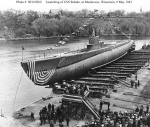 | 166k | The Robalo (SS-273) is ready to tip into the water during her launching at Manitowoc Shipyards, Manitowoc, Wisconsin, 9 May 1943. | Photo by Harry Berns, Official photographer of the Manitowoc Shipbuilding Co., Manitowoc, WI. USNHC photograph USNHC # 69260, courtesy of the Manitowoc Submarine Memorial Association, Manitowoc, Wisconsin, 1970. |
|
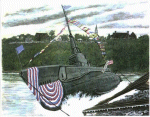 | 55k | Watercolor print by the artist Tom Denton of the side launching of a Manitowoc built boat. | Courtesy of submarineart.com | |
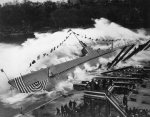 | 555k | The Robalo (SS-273) hits the water with a huge splash, during her launching at Manitowoc Shipyards, Manitowoc, Wisconsin, 9 May 1943. Note the inclination gage mounted on her hull side. | Photo by Harry Berns, Official photographer of the Manitowoc Shipbuilding Co., Manitowoc, WI. USN photo # 080-G-68535, from the Department of Defense Still Media Collection, courtesy of dodmedia.osd.mil. Partial text accompanying photo from U.S. Naval Historical Center # 69261. |
|
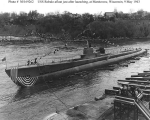 | 139k | Robalo (SS-273), afloat immediately after her launching, at Manitowoc Shipyards, Manitowoc, Wisconsin, 9 May 1943. | Photo by Harry Berns, Official photographer of the Manitowoc Shipbuilding Co., Manitowoc, WI. USNHC photograph USNHC # 69262, courtesy of the Manitowoc Submarine Memorial Association, Manitowoc, Wisconsin, 1970. |
|
 | 103k | Starboard side view of the Robalo (SS-273), underway, probably during her trials in Lake Michigan, Summer 1943. | Photo courtesy of ussubvetsofworldwarii.org. | |
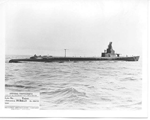 | 177k | Starboard side view of the Robalo (SS-273), underway, probably during her trials in Lake Michigan, Summer 1943. | Photo by Harry Berns, Official photographer of the Manitowoc Shipbuilding Co., Manitowoc, WI. Photo courtesy of John Hummel, USN (Retired). |
|
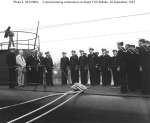 | 73k | Commissioning ceremonies on the Robalo's (SS-273) deck, 28 September 1943. | Photo by Harry Berns, Official photographer of the Manitowoc Shipbuilding Co., Manitowoc, WI. USNHC photograph USNHC # 68804, courtesy of the Manitowoc Submarine Memorial Association, Manitowoc, Wisconsin, 1969. |
|
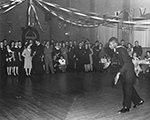 | 160k | Solo dancer at the Robalo (SS-273) commissioning party on 28 September 1943 at the Manitowoc Elks Club, 809 South 8th Street, Manitowoc. | Photo courtesy of Wisconsin Maritime Museum | |
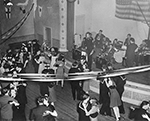 | 176k | Robalo (SS-273) commissioning party dancing in the ballroom of the Elks Club. | Photo courtesy of Wisconsin Maritime Museum | |
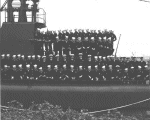 | 97k | Robalo's (SS-273) plank-owners pose on deck, circa September 1943. In a little over 8 months time, the Robalo would be sunk all these men would be M.I.A. | Photo by Harry Berns, Official photographer of the Manitowoc Shipbuilding Co., Manitowoc, WI. Submitted by Larry Bohn, courtesy of the Wisconsin Maritime Museum, home of the Cobia SS-245. |
|
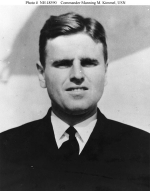 0827309 | 60k | The Robalo's (SS-273) commanding officer, Commander Manning M. Kimmel, who was lost with her and the rest of the ship's company, 26 July 1944. | Photo by Harry Berns, Official photographer of the Manitowoc Shipbuilding Co., Manitowoc, WI. Official USN photo, USNHC # NH 48590, from the collections of the Naval Historical Center. Heroes of the Naval Academy - Manning Marius Kimmel, Video courtesy of youtube.com | |
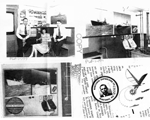 | 485k | Photo of Harry Berns, Official photographer of the Manitowoc Shipbuilding Co., Manitowoc, WI. The photo of the Golet (SS-361) encased in snow appears on the wall above him on the upper right. His obituary appears here. | Photo courtesy of Susan Menk, Archives Assistant, Wisconsin Maritime Museum, Dee Anna Grimsrud, Reference Archivist, Wisconsin Historical Society, Steve Khail, CBC, Director of Investor Relations & Corporate Communications, The Manitowoc Company, Inc. & William Young. | |
 | 456k | Robalo (SS-273), underway near Panama, 19 November 1943. Photographed from a Naval Air Station Coco Solo aircraft, flying at an altitude of approximately 550 feet and on her way to the war. I believe this boat to be Robalo, but the photo shows clear evidence of a censor at work. The photo has been altered to remove the forward fairwater gun deck, and to reconfigure the bridge fairwater. Why, I donít know, especially sense there are many other photographs that show the gun deck in place. Most likely it was taken at the same time as the photo below it, and that one is not altered. During the war, there is a lot of inconsistency when it comes to how and when photos get censored. It seems as if the censoring of photos was left to the local command that took them, and that there was no unified Navy-wide policy on when, if, and how the photos were censored. On several other pages in Navsource I have found evidence of censoring. I was just examining a photo of an O-boat that Ric Hedman has. A censor has blacked out the JK sonar array that is on the forward deck, despite the fact that the sonar array was quite old and well known, and that there are literally hundreds of other photographs of the array on dozens of boats that arenít blacked out. | Photo # 80-G-46478 from NARA, College Park, Maryland, courtesy of Sean Hert. Photo i.d. & text courtesy of David Johnston via John Hummel. |
|
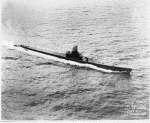 | 416k | Starboard bow view of the Robalo (SS-273), underway in the Gulf of Panama, 19 November 1943. Photographed from a Naval Air Station Coco Solo aircraft, flying at an altitude of approximately 250 feet. | Official USN photo courtesy of John Hummel, USN (Retired). | |
 | 441k | On 26 July '44, LtCdr Manning M. Kimmel's Robalo (SS-273) is sunk probably off the east coast of Balabac Island, PI. Robalo may have hit a mine laid by Tsugaru in March '44. On 13 August '44, LtCdr John D. Crowley's Flier (SS-250) also hit a mine S of Palawan in the Balabac Strait that may have been laid by Tsugaru; however, some mines were also laid in the Balabac Strait in 1943. | Photo & text courtesy of combinedfleet.com. Photo by Takeshi Yuki scanned from "Color Paintings of Japanese Warships". |
|
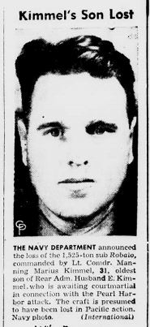 0827326 |
NR | THE NAVY DEPARTMENT announced the loss of the 1,525-ton sub Robalo (SS-273), commanded by Lt. Comdr. Manning Marius Kimmel, 31, oldest son of Rear Adm. Husband E. Kimmel.who is awaiting courtmartial in connection with the Pearl Harbor attack. The craft is presumed to have been lost in Pacific action. | Image and text provided by University of North Carolina at Chapel Hill Library, Chapel Hill, NC. Photo from Henderson Daily Dispatch. (Henderson, N.C.) 1914-1995, 12 September 1944, Image 5, via chroniclingamerica.loc.gov | |
 |
48k | Google Earth satellite photo of the surrounding islands off the east coast of Balabac Island, PI where Robalo (SS-273) sank. | View courtesy of Google Earth. | |
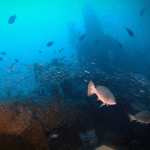 0827349 |
579k | Conning tower of the Robalo (SS-273), May 2019. | Photo courtesy of projectgato | |
 0827330 |
516k | Robalo (SS-273) Wreck Sketch. | Photo courtesy of Karl Hurwood @ projectgato | |
 0827322 |
214k | The explosion in the rear of the vessel has removed several bulkheads of the aft section. The wreck is highly damaged in this area, with the prop shafts still identifiable but mangled out of shape. The red line shows the extend of the missing section based on the wreck survey. | Photos courtesy of projectgato. | |
 0827323 |
455k | The 5 man hatches into the pressure hull were inspected as part of the first project dives. The two hatches by the conning tower section (Messroom - 3 and Control Room - 4 hatch) were found to be open. Note: On the photo the #4 on the escape hatches is not a mess room, it is the control room ladder going up to the conning tower. The aft torpedo room shaft - 1 was destroyed in the explosion, while the aft engine room hatch - 2 and forward escape hatch - 5, were both found to be in closed/sealed positions. | Partial text i.d. via John Hummel, (USN, retired). Photo & text courtesy of projectgato | |
 0827328 | 677k | Approximate Tracks of the Robalo (SS-273) on the night of her loss, 26 July 1944. Propositions by Neil Krumbeck (Researcher with the Sea Scan Survey Team that discovered the wreck of the Robalo on 23 May 2019.) & David Johnston (USN, retired) We know that forty transits had previously been made by US Submarines through the Nasubata Channel without incident. Five of these had been made since the mines had been replenished by the IJN Minelayer Tsugaru on 24 March 1944, including Robalo on 22 April. HQ didn't know that these mines had been laid at the times of the Robalo and Flier (SS-250) briefings, but as the Japanese had mined the channel as early as December 1941, the instructions given in the Operation Order were "Stay clear of readily mineable waters in the vicinity of the Sulu Archipelago and Balabac Strait. Use deepest water routes in transiting Sibutu Passage or Balabac Strait", and that in the intelligence annex, the route followed by the Crevalle (SS-291) through the Balabac Strait - Nasubata Channel - was given. Mines anchored in deeper water were ineffective due to the dip caused by the strong currents in these channels. My view on the mystery of the sinking is that it may never truly be explained, but my theory is that the wreck of Robalo is around 1.5 nautical miles south of the main channel where she should have been transiting, and just under 1 nm south of the Flier wreck. How this occurred is the biggest part of the mystery. To put it simply, after coming up the eastern side of Balabac Island on a NNE heading, the course change to round Comiran Island has been made too early or too sharply. It's difficult to believe how this could happen and I'll refer to the Flier investigation shortly to try and show why. I also can't imagine Commander Kimmel taking this course intentionally without a reason. Whatever the case, I think that Kimmel has ordered a course change to port to head for deeper water bringing the stern into contact with the mine on the starboard side. A similar situation was experienced by Flier. Flier was transiting westward on the night of 13 August and slightly southward of Crevalle's route but this was known by Commander Crowley and deemed safer and more favourable to evasion of enemy patrol craft by giving more room to manoeuvre off Roughton Reef. Continuing on this course would bring Flier into Crevalle's track and deeper water to the north of Comiran Island. "The primary means for determining the position of the vessel was the radar plot and this was checking perfectly. Single ping soundings were taken at frequent intervals to verify the plot, and I required a report from the navigator after each sounding as to how well it agreed with the chart. All soundings were in agreement except the last one of 41 fathoms which was less than expected and I immediately conferred with the navigator relative to a course change to put us into deeper water. At the same time, the possibility of error in reading a single ping sounding was recognized and another was ordered for verification. It was at this time that the explosion occurred." With the outward transit on the night of 3 July, Commander Kimmel had been through here twice before heading west since the mines had been laid, no doubt following HQ's instructions. He was an experienced and determined submarine commander and would have been taking all the navigational procedures and precautions that Commander Crowley had. So how did Robalo end up where it is, so far off course and in "readily mineable waters"? Having no knowledge of the new mines, the only possibility I can think of is that he may have been avoiding an enemy patrol craft sighted on radar, and after passing the threat, started to make the turn back toward the original course. The enemy vessel, knowing the mine field was there, didn't approach after the explosion, and the survivors made their way to Comiran Island where they were captured. Just speculation, but it gives an idea of how a mine strike at the stern could have occurred and why Robalo is at this location. I'm sure that no navigational errors would have been made by any of the crew while transiting this channel, and attached is a chart which gives an idea of the positions. Dave Johnston wrote: The effort we have all undertaken is a difficult one. To try to explain the wartime loss of a submarine, especially when there were no survivors, is not easy, indeed often times we are left to nothing but informed speculation. I would like to think that our ultimate goal is the truth, and as we all know sometimes the truth hurts. The pursuit of the truth has to be balanced with the desire to honor these men (they have earned that), and to give the families left behind some kind of explanation and closure on a difficult time of their lives. |
Photo courtesy of Neil Krumbeck & projectgato.
. Two videos from the dive can be viewed here & here and an explanation of the videos is provided here. | |
 0827350 |
2.45k | I've been corresponding with Rebecca Hughes, author of "Surviving the Flier", who has done a great deal of research on the sub, and she sent me a chart that she put together showing the location of the minefields laid by Tsugaru in March, 1944, including four floating mine incidents. Her research shows that "I-123 laid 40 Type 88 mines in 1941, and Tsugaru laid 600 or so Type 91 Mk 1 mines in March of 1944, yet by 1945, when the strait was swept, only 68 mines (or thereabouts) remained, and floaters had been spotted several miles away." I transferred the location of the western field to the OpenCPN chart, and although a significant amount of mines had drifted free by this stage, it's possible that Flier (SS-250) may have been sunk by a floater. Rebecca always thought this may have been the case, and Commander Crowley stated that he thought that the mine was near the surface. On the other hand, it certainly looks like Robalo (SS-273) was sunk by one of the moored mines in the field. One other point of interest is that when Al Jacobson visited the area around 1997, "he charted a boat to take him to his approximate co-ordinates of the Flier wreck based on his memories. The charter captain assured him that the location he bought Jacobson to was a well known wreck by the local fishermen, AND that on days when the water was clear, the submarine could be seen from the surface." It would appear that he was inadvertantly taken to the Robalo site and not the Flier. The co-ordinates for Al's position on her chart when he visited are incorrect, so have corrected them here. | Photo courtesy of Neil Krumbeck & projectgato. | |
 0827329 |
1.83k | Rear of the hull. | Photo courtesy of Neil Krumbeck & projectgato. | |
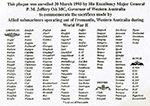 |
365k | This plaque was unveiled 20 March 1995 by His Excellency Major General P.M. Jeffery OA MC, Governor of Western Australia to commemorate the sacrifices made by Allied submarines that operated out of Fremantle, Western Australia during WW II. | Photo courtesy of Ron Reeves (of blessed memory). | |
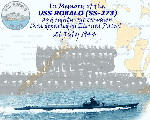 | 46k | Commemorative photo in honor of the memory of the crew of the Robalo (SS-273). | Photo courtesy of Tom Kermen. Dante's Prayer courtesy of Loreena McKennitt via loreenamckennitt.com | |
 | 30k | Commemorative post mark on the occasion of the 60th year of the Robalo's (SS-273) commissioning, 28 September 1943 - 28 September 2003. | Courtesy of Jack Treutle (of blessed memory). | |
 | 65k | Fargo Mayor Dennis Walaker, right, and Duane Sand, state commander of the Submarine Veterans, far left, helped honor David Zier, center, survivor of the Robalo (SS-273) on 2 July 2009 at Lindenwood Park in Fargo. | Photo & text by Sayward Honer & Heidi Shaffer, courtesy of inforum.com. | |
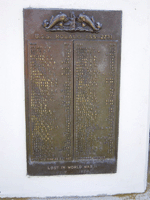 | 65k | Forty Five years in the making, a commitment and a vision becomes a relity in North Dakota. The North Dakota delegates will erect a Memorial to their adopted submarine and its crew-members lost 61 years ago, was fulfilled on Saturday, 23 July 2005. Those that made this commitment and on their eternal patrol, may now rest in peaceÖ"Well done Shipmates, Well Done!". | Photo by waymarking.com. Text courtesy of ussvi.org. |
|
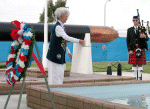 |
117k | Joyce DaSilva, the wife of Jesse DaSilva of the Tang (SS-306), one of the nine survivors of the boat, tosses a flower into a reflecting pool to honor the memory of one of the 52 submarines lost during World War II at the National Submarine Memorial-West on board Naval Weapons Station Seal Beach, Calif. On this Veterans Day, the Submarine Veterans of World War II transferred ownership of the memorial to the U.S. Navy. The following text is from The Coming Fury by Bruce Catton., pg. 478. "Major Sullivan Ballou of Rhode Island was killed in the battle, and just before it he had wrote to his wife, Sarah, to tell her that he believed he was going to be killed and to express a tremulous faith that could see a gleam of light in the dark: "But O Sarah! If the dead can come back to this earth and float unseen around those they loved, I shall always be near you in the gladdest days and in the gloomiest nights, always, always, and if there be a soft breeze upon your chest it shall be my breath, as the cool air fans your throbbing temple it shall be my spirit passing by. Sarah, do not mourn me dead; think I am gone and wait, for we shall meet again!" |
Text i.d. courtesy of Marlynn Starring. Photo i.d. courtesy of Chuck Senior, Vice Commander, Los Angeles-Pasadena Base, USSVI. USN photo # N-1159B-021 by Journalist 2nd Class Brian Brannon, courtesy of news.navy.mil. |
|
 0827325 |
1.99k | Gravestone in memory of Lt. Cmdr. Manning M. Kimmel.
In Memorium: In the Second Book of Shmuel (Samuel), 22nd chapter, 5th through the 20th verses, translated from the original in Hebrew and published by the Koren Publishers of Jerusalem, Israel, 1982, can perhaps aptly describe the fate of the crew and all other U.S. submariners who died defending their county: "When the waves of death compassed me / the floods of ungodly men made me afraid; / the bonds of She'ol encircled me; / the snares of death took me by surprise; / in my distress I called upon the Lord, / and cried to my G-D: / and he heard my voice out of his temple, / and my cry entered into his ears. / Then the earth shook and trembled; /the foundations of heaven moved / and shook because of his anger /...the heavy mass of waters, and thick clouds of the skies /... And the channels of the sea appeared, / the foundations of the world were laid bare, / at the rebuking of the Lord, at the blast at the breath of his nostrils. / He sent from above, he took me; / he drew me out of many waters; / he delivered me from my strong enemy, and from those who hated me; for they were too strong for me. / They surprised me in the day of my calamity: / but the Lord was my stay / He brought me forth also into a large place: / he delivered me because he delighted in me./" | Photo courtesy of findagrave.com | |
View the Rabalo (SS-273)
DANFS history entry located on the Haze Gray & Underway Web Site.
Crew Contact And Reunion Information
U.S. Navy Memorial Foundation
Fleet Reserve Association
Additional Resources and Web Sites of Interest
On Eternal Patrol
ComSubPac Report of loss of USS ROBALO (SS 273) July 26, 1944 - 81 Men Lost
Ep-21 (1) - Victory At Sea ~ Full Fathom Five - HQ
| Back To The Main Photo Index | Back To the Submarine Index |
| Problems and site related matters, E-mail Webmaster |
| This page is created by Gary Priolo and maintained by Michael Mohl All Pages © 1996 - 2023, NavSource History All rights reserved. |